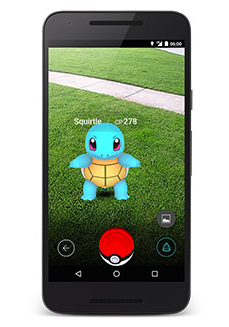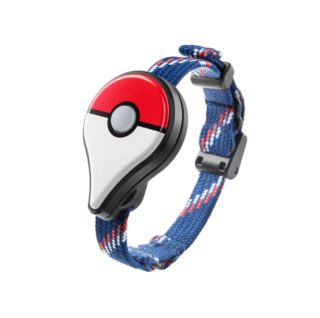Overview

Pokémon GO is a free-to-play augmented reality mobile game developed and released by Niantic (in conjunction with The Pokémon Company) for iOS and Android devices on July 6, 2016 (in the U.S. and Australia). It was later released for European countries on July 13-16, 2016.
Based on the Pokémon series of RPGs, Pokémon GO has players, as Pokémon Trainers, catching virtual creatures (called Pokémon) throughout the real world using the mobile device's GPS (and optionally the device's camera).
As players catalogue their findings on their device's "Pokédex", they earn experience points by doing various tasks (such as interacting with local meeting places called Pokéstops) to level up their Trainer Level, which unlocks new content for the game (including rarer Pokémon to find, new items to help catch them, and the option to battle other Pokémon for the supremacy of local Pokémon Gyms).
While items can be acquired by interacting with Pokéstops, the game includes microtransactions as players can purchase the game's main currency, Pokécoins, with real money.
Gameplay
Players walk around the real world, capturing Pokemon and collecting items at Pokestops. Various gyms are placed at landmarks, and three different teams fight for control of these gyms by leaving their most powerful Pokemon there to guard the location. A rudimentary fighting mechanic is included for players who want to train at a friendly gym or fight to overtake a gym controlled by the enemy team.
Catching Pokémon
As the player walks around, they will randomly encounter the various Pokémon of the Kanto and Johto regions of the Pokémon world. The player then taps on a Pokémon to engage in a battle with it. The player may choose to throw various forms of Pokéballs at it, or throw a berry at it. Berries may change the odds of successfully capturing the Pokémon, slow the Pokémon down to make it easier to hit, or increase the amount of candy gained from a successful capture.
To capture a Pokémon, the player swipes a Pokéball in the direction of the Pokémon in an attempt to hit it with the Pokéball. More advanced throws, such as spinning the Pokéball prior to throwing it, may be used to improve the odds of successfully catching the Pokémon.
When the Pokémon is successfully captured, it is added to the player's Pokédex, if it is not already, and adds it to the player's inventory.
Strengthening and Evolving Pokémon
The player can gain "stardust" by catching Pokémon, hatching eggs, or by defending gyms. Stardust is used to strengthen individual Pokémon to increase their Combat Points (CP). CP is one determinant of the Pokémon's success in gym battles.
The player has the option of trading in Pokémon in exchange for candies of that specific Pokémon. The player may then stockpile their candies until they have enough to evolve a Pokémon in their party. Evolution grants a large CP bonus and the Pokémon becomes its evolved form, which may have different moves.
Hatching Pokémon
Hatching eggs is simply another way to acquire Pokémon. The player will randomly find eggs throughout their encounters. Each egg has a predetermined distance at which it will hatch. The player must use an incubator to hatch eggs. Incubators are acquired when the player reaches a new trainer level and can also be purchased using real-world currency. Incubators can be used more than once.
After the player has walked the predetermined distance for the specific egg, the egg will hatch and give the player a Pokémon which is randomly determined by the distance required to hatch the egg.
Pokémon GO Plus

The Pokémon GO Plus is an optional wearable accessory released by Nintendo that allows players to interact with nearby Pokémon and Pokéstops without requiring them to use their mobile device. Retailing for $34.99 USD, it resembles a combination of a poké ball and a Google Maps pin and connects to the player's mobile device via Bluetooth.
Unlike the Pokéwalker accessory for Pokémon HeartGold/SoulSilver, the Pokémon GO Plus is not a pedometer and is not a substitute for carrying the actual mobile device with the game running.
Poké Ball Plus

The Poké Ball Plus is another optional accessory released by Nintendo together with the games Pokémon Let's Go Eevee and Pokémon Let's Go Pikachu. It can be used as a Joy-Con controller for the Nintendo Switch.
When connected to Pokémon GO via Bluetooth, the Poké Ball Plus is similar to the Pokémon GO Plus in terms of functionality, but with a few differences. Pokéstops can be spinned automatically if a Pokémon from the Pokémon Let's Go games is taken for a stroll inside the Poké Ball.
Log in to comment